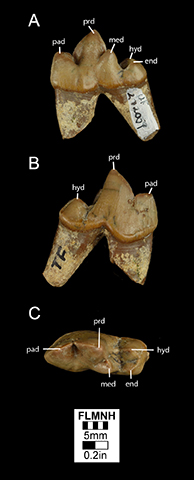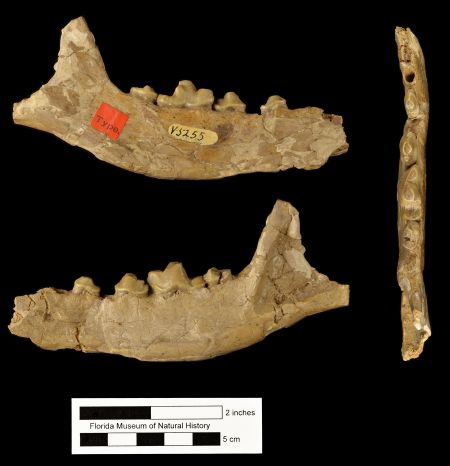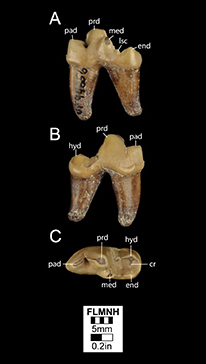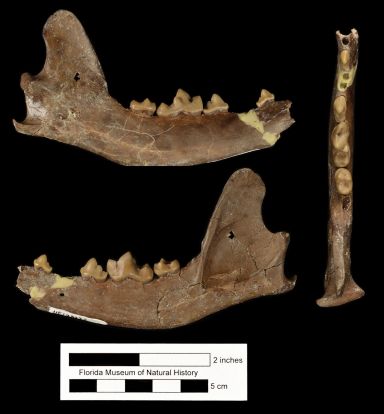Osbornodon iamonensis
Quick Facts
Common Name: Iamonia dog
The species is the most abundant carnivore at the Thomas Farm fossil site.
It was about the size of a modern coyote, and probably had a similar omnivorous diet.
Age Range
- Early Miocene Epoch; late Arikareean to early Hemingfordian land mammal ages
- About 21 to 18 million years ago
Scientific Name and Classification
Osbornodon iamonensis Sellards, 1916
Source of Species Name: Named after Lake Iamonia, which is near the type locality of the species.
Classification: Mammalia, Eutheria, Laurasiatheria, Ferae, Carnivora, Caniformia, Canoidea, Canidae, Hesperocyoninae
Alternate Scientific Names: Mesocyon iamonensis; Cynodesmus iamonensis; Cynodesmus nobilis; Paradaphoenus nobilis; Paradophoenus tropicalis
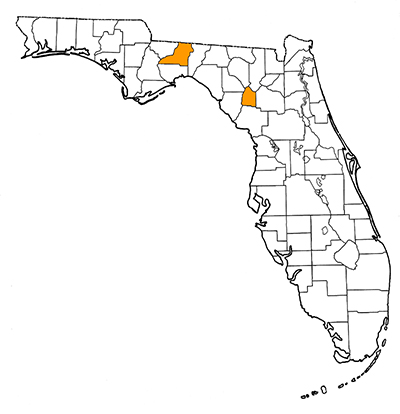
Overall Geographic Range
In addition to the two Florida localities where Osbornodon iamonensis has been found, it has also been identified from two sites in western Nebraska.
Florida Fossil Occurrences
Florida fossil sites with Osbornodon iamonensis:
- Gilchrist County—Thomas Farm
- Leon County—Griscom Plantation
Discussion
Osbornodon iamonensis is an omnivorous, coyote-sized member of the dog family that lived during the early Miocene and has a limited fossil record; there are a small number of localities (4) where Osbornodon iamonensis has been identified, but many specimens have been recovered, especially at Thomas Farm. As a result of many decades of field work there, a large collection of cranial material for Osbornodon iamonensis is now housed at the Florida Museum of Natural History and Harvard’s Museum of Comparative Zoology.
Osbornodon iamonensis has had a complex taxonomic history since its original discovery. The holotype was discovered in the early 1900s and was originally described by Sellards (1916) as Mesocyon iamonensis. Similar fossils were later recovered at Thomas Farm and were originally regarded as a distinct species named Cynodesmus nobilis (Simpson, 1932). Simpson (1932) noted the similarities between Cynodesmus nobilis and Mesocyon iamonensis, but concluded that the two were not conspecific. He argued that Mesocyon iamonensis was also a species of the genus Cynodesmus rather than a member of the genus Mesocyon. White (1942) placed Simpson’s species in another genus, Paradaphoenus. He also named a second, slightly smaller species in this genus from Thomas Farm, Paradaphoenus tropicalis. Olsen (1956) cleared up the worst of this mess, demonstrating that Cynodesmus iamonensis, Cynodesmus nobilis, and Paradaphoenus tropicalis were a single species, for which the name Cynodesmus iamonensis has priority and is the senior synonym. This general result has held up for past 60 years. Wang (1994) conducted the first systematic review of the canid subfamily Hesperocyoninae, to which Osbornodon iamonensis belongs. He agreed with Olsen’s (1956) that the three species were synonymous. Wang’s (1994) modern analysis of the evolutionary relationships of the species belonging to the Hesperocyoninae resulted in the recognition of many new genera, one of which was Osbornodon. His analysis placed the Thomas Farm hesperocyonine in the same monophyletic group as the type species of Osbornodon, O. fricki. He therefore referred Sellards’ species to Osbornodon.
Hesperocyoninae represents the most primitive subfamily of dogs. They are identified by a few distinct features: a basined talonid in the lower first and second molars, more quadrate and enlarged upper second molars, and enlarged lower second molars. The basined talonid is created due to the lack of a cross-ridge running from the hypoconid to the entoconid through the talonid basin on the lower first and second molars (Figure 2). In other canids, the entoconid appears more cusp-like rather than ridge-like. O. iamonensis has a more ridge-like entoconid instead. This characteristic can be seen from the mandible (Figure 3), as well. Additionally, O. iamonensis lacks a lingual subsidiary cusp on the lower first molar which is present in other canids found at Thomas Farm, such as Metatomarctus canavus (Figure 4 and 5).
Osbornodon iamonensis shows many derived features not found in more primitive Osbornodon species, but some primitive features are retained when compared to even more derived Osbornodon species. Compared with the more primitive O. sensoni and O. renjiei, Osbornodon iamonensis has a more elongated rostrum, an enlarged p4, a reduced mastoid process, and a few other features that are considered derived. However, in comparison with more derived taxa such as O. fricki, O. iamonensis retains primitive characteristics (Wang, 1994). Postcranial material from Osbornodon iamonensis has not been described in the scientific literature, however several elements have been assigned to the species based on the size of the specimens. Because these elements have not been found in association, however, these assignments are not considered particularly strong and so are not mentioned here.
Osbornodon iamonensis co-occurs with several other dogs at the well-sampled Thomas Farm site. These are all members of a different subfamily, the subfamily Borophaginae. At least three borophagines are present at Thomas Farm: Metatomarctus canavus, Euoplocyon spissidens, and Phlaocyon sp. They are smaller than O. iamonensis and have important differences in cranial and dental morphology (compare Figures 2 and 5; Olsen, 1956; Wang, 1994).
Sources
- Original Author: Sean M. Moran
- Original Completion Date: December 4, 2012
- Editors’ Names: Natali Valdes, Richard C. Hulbert Jr.
- Last Updated On: June 23, 2021
This material is based upon work supported by the National Science Foundation under Grant Number CSBR 1203222, Jonathan Bloch, Principal Investigator. Any opinions, findings, and conclusions or recommendations expressed in this material are those of the author(s) and do not necessarily reflect the views of the National Science Foundation.
Copyright © Florida Museum of Natural History, University of Florida
